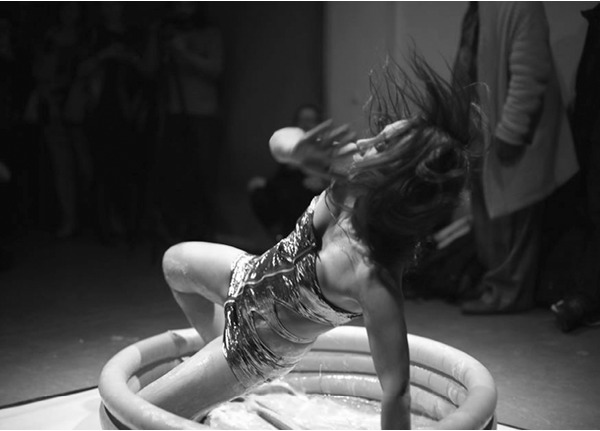
SOAP DANCE
first performed on October 19, 2018
Grace Exhibition Space, New York, NY
performed once in 2018
LEAH ARON
Brooklyn, NY
020932140a020932140r020932140o020932140n020932140.020932140l020932140e020932140a020932140h020932140@020932140g020932140m020932140a020932140i020932140l020932140.020932140c020932140o020932140m
leaharon.com
SOAP DANCE
LEAH ARON
“Soap Dance” was an attempt to simultaneously alter my state of consciousness through physical exhaustion and present an aesthetically appealing calamity to viewers.
Wearing a skimpy silver metallic tube dress, I walked through the crowd toward a blue inflatable pool. Music faded in, a lilting string instrumental version of Lana Del Rey’s “Ride.” I could hear the lyrics in my head. I felt hers was the only voice that could power me through the mental and physical challenge of performing this particular work.
The pool, filled with two gallons of lavender-scented hand soap, was my dance floor, and my job was to fight gravity. I placed a sheet of white vinyl on the floor, reinforced by yoga mats, to break my inevitable falls on the concrete. For the duration of the performance, I slipped around wildly and often took hard falls. My feet flew up in the air as strands of white goo spun from the ends of my fingers. I inadvertently made jerky, erratic movements, often seizure-like, while trying to stay upright. I did sway, spin, even glide. But these minute expressions of composure felt like accidents. Convulsive dancing and cartoonishly dramatic falls dominated the performance.
I was greatly inspired by Indonesian performance artist Melati Suryadarmo’s “Exergie-Butter Dance,” in which she danced on 20 pounds of butter wearing heels. I saw a rawness, an ugliness and realness in this work. She was reenacting the elaborate, excruciating performance that is being a woman. I was trying to use my body to articulate what my mouth couldn’t. Dancing. Falling. Getting back up. Repeat.
“Soap Dance” explored femininity in the register of the absurd. I presented a kind of parody of the cycle of earnest effort and unpredictable failure. This piece was painful to perform, and painful to watch. I wanted to draw out a feeling of worry on the part of viewers, and to make them complicit in this very physical precarity.
The audience, in the same room with a woman subjecting herself to a masochistic reenactment of the female condition, was silent. Afterward, many told me they had felt concern. Some were amused but also felt sorry for me. Speaking to my own experience as the performer: I cherished making people uncomfortable. Through exhaustion, I made myself high. I was hurt but felt no pain. Even without an opponent, I still was in a fight.